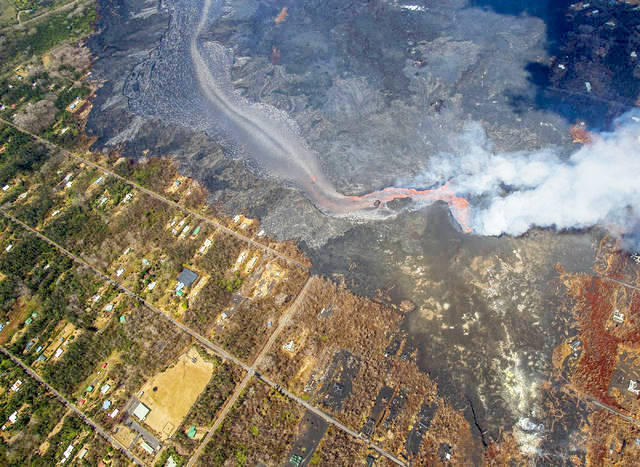HILO — The results of three community surveys administered this summer — which aim to aid the county in its recovery from the 2018 eruption of Kilauea volcano — highlight the impact the eruption had on households, businesses and the community.
Reports and results of each survey have been posted on the county’s Kilauea Eruption Recovery website.
“The survey results give us a snapshot of what residents and businesses are experiencing a year after the eruption,” said Diane Ley, director of the county Department of Research and Development and Kilauea recovery manager. “For example, 24% of those participating in the Household Impact Assessment said they still have housing needs. While a large majority have received housing recovery services, this highlights that more work needs to be done to assist eruption survivors.”
Additionally, Ley said the Community Impact and Opportunity Assessment “showed strong support for recovery objectives previously vetted by the Puna Community Development Plan Action Committee.”
More than 600 residents participated in the Household Impact Assessment, which looked to clarify the unmet needs families are experiencing and guide family outreach and long-term community planning.
Out of 576 responses, 24% said they still have outstanding housing needs.
Main areas in which residents have housing needs include affordable housing options, infrastructure/utilities and assistance with repairs and rebuilding, the survey found.
According to the survey results, 82% of people have received housing recovery services. Assistance from the Federal Emergency Management Agency was the most common type of housing recovery services individuals received.
More than 40% said their living condition had worsened after the eruption, and 45% said it had remained the same. Another 15% said their living condition improved.
A majority of those who responded — 45% — said they were not willing to relocate outside of Puna for an available housing option; 6% have already relocated; and 24% would.
Of those seeking to return to their property, 31% would do so if they can afford to rebuild, or if they get access, while 12% already have returned. Meanwhile, 27% are not looking to return because they can’t afford to, they lack access or utilities, there’s too much lava, there are health concerns, or because it no longer feels like home.
Additionally, more than 200 Business Impact Assessment surveys representing 21 economic sectors were completed.
That survey followed up on a business survey sent in the early days of the eruption to identify ongoing economic impacts as well as challenges and opportunities for business recovery.
According to the results, hospitality and agriculture sectors were the most prominently represented in the survey responses, and 56% of those surveyed have operated for more than 10 years.
More than a third of businesses, or 39%, have closed, 12% are open but in need of repairs, 23% are open but not at full staff, and 24% are open at full staff levels. Another 2% of responding businesses have relocated.
According to the survey, 49 businesses remain closed, 22 were closed 4-14 months, 18 were closed 1-3 months, eight were closed less than a month, and nine were closed less than two weeks. Seventy businesses did not close.
Thirty-two percent of businesses reported staying open but saw customer/market decline. Revenue declined for 75% of businesses, and 54% of businesses reported a decrease in customers.
Meanwhile, 63 businesses are considering closing permanently, and 44 are considering relocation.
The number of employees have also decreased post-eruption, according to the survey, from 1,317 to 918. Fifty-three percent of those businesses report that lost revenue is the reason for the decrease in employees.
Finally, nearly 400 residents completed the Community Impact and Opportunity, which will guide decisions about long-term recovery, including hazard mitigation, land use and natural and cultural resource management, infrastructure investments, housing and economic development.
Of those who responded, 69% were living in Puna and 22% were on Hawaii Island but living outside of Puna; 1% now live on Maui or Oahu, and 8% now live on the mainland.
According to Ley, the survey results will help inform the Recovery Strategic Plan. This will ensure that recovery strategies are aligned with community members’ visions for the future and long-term needs.
Email Stephanie Salmons at ssalmons@hawaiitribune-herald.com.

